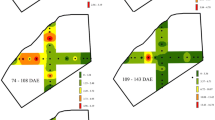Abstract
Population dynamics of pink bollworm on cotton was studied through male moths captured in the traps baited with sex pheromone ‘gossyplure’ and by its damage to the flowers and green bolls during 1978 and 1979 crop seasons. The number of pink bollworm male moths captured in traps were low up to August. Maximum moth population was recorded from the second fortnight of September to the second week of November. The population started declining after the first fortnight of November, indicating that most of the larvae had entered diapause due to the short photoperiod and low temperature. Incidence of pink bollworm on flowers was high up to the last week of August, after which it declined. While on green bolls its infestation started in the beginning of August and continued to increase up to the end of the season. A linear and highly positive correlation was found between the male moth catches in traps and the larval damage in flowers and bolls (r = 0.84 and 0.95 in 1978 and 1979 crop seasons, respectively).
Résumé
La dynamique des populations du ver rose du cotonnier a été étudiée à l’aide des papillons mâles capturés par des pièges appâtés avec des phéromones sexuelles ‘gossyplure’ et des dégâts causes aux fleurs ainsi qu’aux capsules vertes au cours des campagnes 1978–1979. Le nombre des mâles du ver rose du cotonnier capturés a été bas jusqu’au mois d’août. La population a atteint son maximum à partir de la troisième semaine de septembre jusqu’à la deuxième semaine de novembre, mas a ensuite diminué suite à l’entrée en diapause de la plupart des larves à cause de la courte photopériode et des basses températures. L’incidence des vers roses du cotonnier sur les fleurs a été plus élevée jusqu’à la fin août et a ensuite baissé tandis que son infestation a commencée sur les capsules vertes au début d’août et a continué de s’aggraver jusqu’à la fin de la saison. Une corrélation linéaire et hautement positive a été observée entre les niveaux de capture et celui de l’infestation sur les fleurs et les capsules (r = 0,84 et 0,95 dans les campagnes 1978 et 1979 respectivement).
Similar content being viewed by others
References
Adkisson P. L. (1961) Fecundity and longevity of the adult female pink bollworm on natural and synthetic diets. J. econ. Ent. 54, 1224–1227.
Adkisson P. L., Bell R. A. and Wellso S. G. (1963) Environmental factors controlling the induction of diapause in the pink bollworm, Pectinophora gossypiella (Saunders). J. Insect Physiol. 9, 299–310.
Brazzel J. R. and Martin D. F. (1957) Oviposition sites of the pink bollworm on cotton plants. J. econ. Ent. 50, 122–124.
Bulter G. D. Jr, Hamilton A. G. and Gatienez A. P. (1978) Pink bollworm: Diapause induction in relation to temperature and photophase. Ann. ent. Soc. Am. 71, 202–204.
Chapman A. J., Robertson O. T. and Noble L. W. (1961) Evaluation of stalk shredders and other cutters for pink bollworm control. J. econ. Ent. 54, 791–792.
Crowder L. A., Watson T. F. and Langston D. T. (1975) Diapause of the pink bollworm as related to crop maturity. J. econ. Ent. 68, 110–112.
Graham H. M., Robertson O. T., Adkisson P. L. and Wilkes L. H. (1961) Further tests on the effectiveness of cotton stalk shredders for controlling the pink bollworm. J. econ. Ent. 54, 1057–1058.
Gupta D. S. and Khurana A. D. (1971) Seasonal activity and chemical control of pink bollworm. FAO Pl. Protect. Bull. 19, 131–135.
Hussain M. A. and Khan M. H. (1940) Studied on Platyedra gossypiella (Saunders) in the Punjab. Part IV. Relative incidence on exotic and indigenous varieties of cotton. Indian J. Ent. 2, 45–47.
Katiyar K. N. (1977) Impact of sequence of flowering on the incidence of bollworms in some varieties of cotton. Indian J. Ent. 39, 324–332.
Katiyar K. N. and Butani D. K. (1978) Incidence of bollworms vis-a-vis development of cotton bolls. Indian J. Ent. 40, 245–253.
Kittock D. L. and Pinkas L. L. H. (1971) Effect of pink bollworm on cotton seed and fibre. Cott. Grow. Rev. 12, 92–94.
Lukefahr M. and Griffin J. A. (1956) The effect of food on the longivity and fecundity of pink bollworm moths. J. econ. Ent. 49, 876–877.
Lukefahr M. J., Noble L. W. and Martin D. F. (1964) Factors inducing diapause in the pink bollworms. Tech. Bull. No. 1304, USDA publication.
Noble L. W. and Robertson O. T. (1964) Methods of determining pink bollworm population in blooms. J. econ. Ent. 57, 501–503.
Shaaban A. M. and Radwan H. S. (1974) Population dynamics of pink bollworm, Pectinophora gossypiella (Saunders) in relation to blooming and fruiting curves of cotton plants. Z. PflKrankh. PflSchutz. 81, 206–211.
Sohi G. S. (1964) Pests of cotton. In Entomology in India, pp. 111–148. Entomological Society of India Silver Jubilee Publication, New Delhi.
Sukhija H. S. and Sidhu A. S. (1977) Studies on some aspects of the oviposition behaviour of the pink bollworm, Pectinophora gossypiella (Saunders). J. Res. Punjab Agric. Univ. 14, 309–313.
Author information
Authors and Affiliations
Rights and permissions
About this article
Cite this article
Taneja, S.L., Jayaswal, A.P. Population Dynamics of Pink Bollworm, Pectinophora Gossypiella (Saunders) on Upland Cotton. Int J Trop Insect Sci 7, 569–573 (1986). https://doi.org/10.1017/S1742758400009851
Received:
Revised:
Published:
Issue Date:
DOI: https://doi.org/10.1017/S1742758400009851




